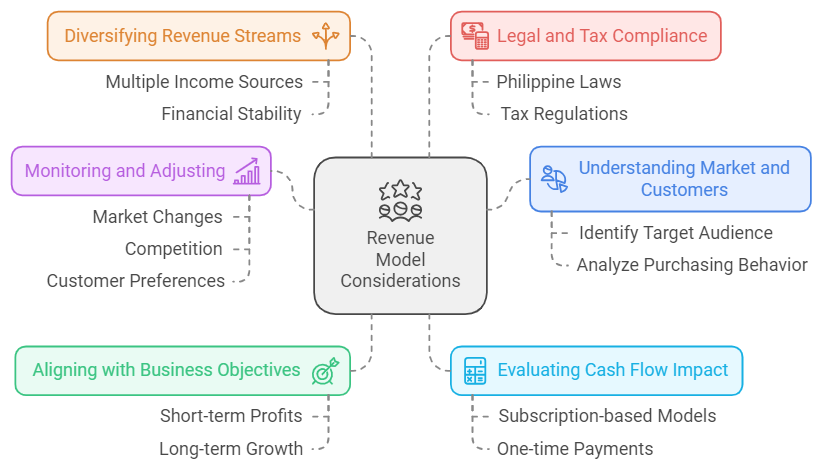Understanding the various types of revenue is essential for effective financial management and the growth of businesses in the Philippines. Revenue streams can differ based on the industry, business model, and target market, but all play a crucial role in determining a company's profitability and sustainability.
In this blog, we will explore the different types of revenue sources commonly found in Philippine businesses, including sales revenue, service income, and other streams that contribute to a company’s overall financial health.
Moreover, thoroughly reviewing these aspects will help Filipino entrepreneurs and business owners optimize their strategies and maximize their income for the long term. So, without any more delays, let us get down to all the relevant details.

What is Revenue in a Business?

Revenue refers to the total income a company generates from its normal business activities, typically through the sale of goods or services. It represents the "top line" of a business's income statement and is a crucial indicator of its financial performance.
Revenue is crucial for covering operational costs, reinvesting in the business, and ensuring profitability. In simple terms, it is the money earned before deducting any expenses.
Importance of Revenue For a Business in The Philippines
Revenue is the lifeblood of any business, including those operating in the Philippines, because it drives a company's financial stability and growth by enabling day-to-day operations and funding future expansion.
Here, take a look at a few reasons why revenue is essential for a Philippine business -
1. Operational Sustainability
Revenue provides the necessary funds to cover daily expenses like salaries, rent, and utilities, ensuring smooth business operations.
2. Profitability and Growth
Consistent revenue generation allows businesses to achieve profitability and reinvest in expansion opportunities, such as new products, locations, or services.
3. Financial Planning and Stability
Reliable revenue streams help businesses in the Philippines plan for future investments, manage cash flow, and build emergency financial reserves.
4. Attracting Investors and Lenders
Strong revenue figures make a business more attractive to potential investors, lenders, or financial institutions, increasing access to funding and capital.
5. Building Market Competitiveness
Higher revenue enables businesses to invest in marketing, product innovation, and customer service, improving marketplace competitiveness.
Also Read: Best Medical Practice Loans For Physicians in The Philippines
What Role Does Sales Play in Revenue For a Business?
Sales are critical in driving revenue for a business, as they directly represent the income generated from selling goods or services. In most companies, sales are the primary source of revenue and serve as the foundation for financial stability and growth.
The effectiveness of a business's sales strategy impacts its ability to generate consistent income, fund operations, reinvest in business development, and achieve profitability.
In summary, sales are a business's core revenue component, directly influencing its financial health and capacity for expansion.
Also Read: Guide to Best Restaurant Business Loans for Small Businesses in 2024
Critical Differences Between Profit And Revenue For a Business
While revenue and profit are often used interchangeably, they represent distinct aspects of a business’s financial performance. Hence, understanding their critical differences is essential for business owners in the Philippines, as it will allow them to evaluate their company’s economic health and make correct financial decisions for the present and the future.
Here, take a look at the critical differences between profit and revenue for businesses in the Philippines -
1. Definition
Revenue is the total income a business generates from its sales and services, while profit is the income remaining after all expenses, taxes, and costs are subtracted from the revenue.
2. Position on Financial Statements
Revenue is often referred to as the "top line" in an income statement, representing total earnings, while profit, known as the "bottom line," reflects the actual earnings after deductions.
3. Core Purpose
Revenue shows the business's ability to generate income, whereas profit indicates how efficiently the company manages its costs and how much money it retains from its operations.
4. Impact on Business Decisions
Revenue helps evaluate sales performance and market demand, while profit assesses financial viability and long-term sustainability.
5. Types
Revenue is typically categorized into operating revenue from core activities and non-operating revenue from non-core activities. In contrast, Profit is divided into gross profit, operating profit, and net profit, each representing different income stages after specific costs.
Also Read: Small Business Startup Loans for Minorities Guide
Types of Revenue For a Business in The Philippines
Generating revenue from diverse sources is essential for a business’s growth and sustainability in the Philippines. Companies can earn income through various revenue streams depending on their industry and business model.
Here, take a look at the different types of revenue sources for a business in the Philippines -
1. Sales Revenue
This is the primary source of income for businesses, earned from the sale of goods or services. It reflects the core business activities and is often the most significant contributor to overall revenue.
2. Service Revenue
For service-oriented businesses, this revenue is generated by providing services to clients, such as consulting, repair services, or professional advice.
3. Interest Revenue
Some businesses earn income from their financial assets, such as savings accounts, investments, or loans to other companies. This revenue comes in the form of interest.
4. Rental Revenue
Companies that lease property or equipment generate rental revenue from tenants or users, providing a consistent income stream without active production.
5. Royalties and Licensing Revenue
Businesses that own intellectual property, like patents, trademarks, or software, can earn revenue by licensing these assets to others in exchange for royalty payments.
6. Dividend Revenue
Businesses holding shares in other companies may receive dividend payments, representing a share of the profits from these investments.
Also Read: Housing Loan Processing Fees and Required Documents Checklist
Transform Your Business with N90’s Fast Financing Solutions! Apply online and get loan approvals within 24 hours! Push your Philippine SME towards success in the long term! Get in touch with us today!
Different Types of Revenue Models For Businesses in The Philippines

Revenue models are the frameworks businesses use to generate income through various activities. Hence, it is essential for Filipino companies to carefully understand revenue models and how they work because each model offers unique advantages depending on a business’s industry and target audience.
Here, take a look at the most prominent revenue models available in the Philippines -
1. Product Sales Model
Businesses generate revenue by selling physical or digital products directly to consumers. This is common in the retail, e-commerce, and manufacturing sectors.
2. Service-Based Model
Revenue is earned by offering services such as consulting, legal, medical, or technical services. This model is popular among freelancers and professional service providers.
3. Subscription Model
Customers pay recurring fees to access products or services, usually monthly or annually. This model is widely used in industries like streaming services, SaaS, and media.
4. Advertising Model
Businesses earn revenue by selling advertising space to other companies. This is often seen in media outlets, blogs, and online platforms that generate traffic.
5. Commission-Based Model
Revenue is generated by charging a commission to enable transactions between buyers and sellers. This is common in e-commerce platforms, real estate, and recruitment agencies.
6. Licensing and Royalty Model
Businesses license intellectual property or technology to other companies in exchange for royalties. This model is prevalent in industries like entertainment, technology, and franchising.
7. Affiliate Revenue Model
Businesses earn a percentage of sales by promoting other companies’ products or services. This model is often used in online marketing and blogging.
8. Pay-Per-Use Model
Customers are charged based on their product or service usage, making it suitable for utilities or cloud-based services.
9. Franchise Model
Businesses allow others to operate under their brand and business model in exchange for franchise fees and royalties. This is common in the fast food, retail, and hospitality sectors.
10. Donations and Crowdfunding Model
Revenue is generated through voluntary donations or crowdfunding platforms, often used by non-profits, artists, or startups seeking initial capital.
Also Read: Bridge Financing in The Philippines: How It Works and Notable Examples
How To Record Revenue For Accounting in The Philippines
Recording revenue accurately is crucial to maintaining a business's financial health in the Philippines. Properly tracking and reporting revenue ensures compliance with regulatory requirements and clarifies a company’s economic performance. Philippine businesses follow the Philippine Financial Reporting Standards (PFRS) for revenue recording.
Here, take a look at the key steps to record revenue in accounting in the Philippines -
1. Identify Revenue Source
Determine the nature of the revenue, e.g., from sales, services, or other sources. Each type of revenue may have specific recording requirements.
2. Issue Invoice
Issue an invoice for the goods sold or services provided. This invoice serves as the basis for recording revenue in your accounting books.
3. Revenue Recognition
Apply the accrual accounting method, meaning revenue is recorded when earned, not when cash is received, as the PFRS requires. This ensures accurate financial statements.
4. Journal Entry
Record revenue by making a debit entry to accounts receivable or cash and a credit entry to the revenue account.
5. Tax Compliance
Ensure compliance with the Bureau of Internal Revenue (BIR) requirements. Businesses must issue Official Receipts (OR) and Sales Invoices (SI) for every transaction to record and report revenue accurately.
6. Tracking Revenue Streams
Use accounting software or a system to track different revenue streams, ensuring that revenue from various sources is categorized and recorded correctly.
Also Read: Top Long-Term Personal Loans of 2024 in The Philippines
How To Implement The Correct Revenue Model - Key Points For Philippine Businesses To Consider
Choosing and implementing the correct revenue model is crucial for the success and sustainability of businesses in the Philippines because a well-structured revenue model helps companies monetize their products or services effectively, manage cash flow, and drive profitability.
Here, check out the key points they must consider when selecting and implementing a revenue model -

1. Understand Your Market and Customers
Identify your target audience and analyze their purchasing behavior to choose the most suitable revenue model. Understanding customer needs ensures your business provides value while maximizing revenue.
2. Align with Business Objectives
The revenue model must align with your overall business strategy and objectives, whether you want to maximize short-term profits or focus on long-term growth.
3. Evaluate Cash Flow Impact
Consider how different revenue models, such as subscription-based or one-time payments, affect your cash flow. Choose a consistent cash flow model to cover operational costs and investments.
4. Diversify Revenue Streams
Where possible, diversify your revenue sources to reduce dependency on one income stream. This can increase financial stability and resilience, especially in uncertain markets.
5. Monitor and Adjust
Continuously monitor your revenue model's performance. Be prepared to adjust based on market changes, competition, or evolving customer preferences to optimize profitability.
6. Legal and Tax Compliance
Ensure your revenue model complies with Philippine laws and tax regulations. To avoid legal complications, properly account for revenue and follow the Bureau of Internal Revenue (BIR) guidelines.
Also Read: Loan Table for Teachers with EastWest Bank
Costs And Challenges Involved in Revenue Generation For a Philippine Business
Generating revenue is essential for any business's growth and sustainability. However, for companies in the Philippines, achieving consistent revenue generation often comes with various costs and challenges.
This is because these costs and challenges can impact a business’s profitability and operational efficiency, making it crucial for Filipino business owners to understand and manage these aspects effectively.
Here, take a look at the costs and challenges faced by Philippine businesses during the revenue generation process -
1. Operational Costs
Expenses like salaries, rent, utilities, and inventory directly impact revenue generation. Balancing these costs while maintaining efficient operations can be challenging for businesses.
2. Marketing and Sales Expenses
Promoting products and services requires investment in advertising, digital marketing, and sales efforts. Businesses need to allocate funds effectively to reach target audiences without overspending.
3. Competition
The competitive landscape in the Philippines can limit a company’s market share, requiring businesses to innovate and differentiate themselves to capture revenue.
4. Regulatory Compliance
Adhering to local regulations, taxes, and industry standards incurs additional costs and administrative burdens, which can challenge businesses in terms of both time and money.
5. Economic Fluctuations
Economic downturns, inflation, and fluctuating currency rates can negatively affect consumer purchasing power, reducing a business’s revenue potential.
6. Technological Investments
Staying competitive often requires investments in technology, such as e-commerce platforms, digital payment systems, and CRM tools, which can be costly for small and medium-sized businesses.
7. Logistical Challenges
Managing supply chains, shipping costs, and inventory control in a geographically diverse country like the Philippines can hinder efficient revenue generation.
8. Customer Retention
It’s costlier to acquire new customers than to retain existing ones, and businesses face the challenge of keeping customers satisfied and loyal, often through discounts, promotions, or enhanced service quality.
Conclusion
As this article highlights, exploring the different types of revenue in business is crucial for building a resilient and adaptable financial structure in the Philippines. This is mainly because every kind of revenue offers unique benefits and challenges, whether from product sales, services, subscriptions, or investments.
By understanding and strategically including various revenue streams in their systems, Philippine businesses can eliminate the risks and tap into new growth opportunities to ensure a steady cash flow.
Moreover, a well-rounded approach to revenue generation positions a company for long-term stability and success in any market environment. However, to be in the best possible shape, businesses must be well aware of how to select and implement the best revenue model to suit their needs and the costs and potential challenges involved.
Frequently Asked Questions (FAQs)
1. What are the three main types of revenue models?
The three main types of revenue models are transactional, recurring, and project-based.
- Transactional revenue comes from one-time sales of products or services.
- Recurring revenue, often through subscriptions or memberships, provides continuous income over time.
- Project-based revenue is earned by completing specific tasks or projects, usually tied to a fixed contract or time frame.
2. What are the different types of revenue models applicable to e-business?
E-business revenue models are divided into 4 categories. They are as follows -
- Subscription - Here, users pay regularly for access to specific services.
- Transactional - This involves earning revenue from product or service sales.
- Advertising - Generating income through ads displayed to users.
- Affiliate marketing - Earning commissions by promoting third-party products.
- Freemium - Offering essential services for free while charging for premium features or upgrades.
3. What type of revenue is a business’s earning?
A business's earnings typically fall into operating revenue and non-operating revenue. Operating revenue is generated from the core activities, such as selling products or providing services.
On the other hand, non-operating revenue comes from secondary activities like investments, interest, or asset sales. Both types contribute to the business's overall financial health but differ in sustainability and source.
4. What is revenue generation in business?
Revenue generation in business refers to the process of earning income by selling products, offering services, or utilizing other business activities. It involves various strategies to attract customers, increase sales, and create multiple income streams.
Effective revenue generation is essential for covering operational costs, ensuring profitability, and driving business growth, making it a key focus for long-term success.













